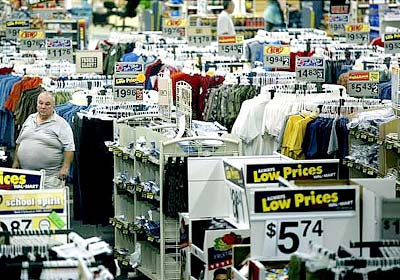Jumping in bed with the devil--it's hot, but will you survive the heat?
 A shopper stands in the aisles at a Las Vegas Wal-Mart Supercenter.(Genaro Molina / Los Angeles Times) July 28, 2003
A shopper stands in the aisles at a Las Vegas Wal-Mart Supercenter.(Genaro Molina / Los Angeles Times) July 28, 2003 The problem with Wal-Mart isn't so much that it is a behemoth store. The problem is their business model, which appears to be designed to capture as much as 100%* of the average customer's retail expenditure dollars. That doesn't leave much room, even crumbs, for other businesses. (* or more than 100% if you consider credit cards...)
This doesn't take into account other issues, such as their uncomfortability with dispensing certain legal prescription drugs (my personal take on this is pretty simple--a pharmacist or pharmacy that refuses to dispense a legal drug for any reason should lose their license). Or their focus on the absolute lowest price (which can come at the expense of quality and product longevity) which is moving most of their business sourcing to the world of the lowest wage--China, at the expense of U.S. manufacturing.
Getting back to Wal-Mart's desire for 100% of the dollars in your wallet (I haven't commented too much on their introduction of new upscale Wal-Mart stores. One opened in Arizona when I was out there a few weeks ago)...
This is completely different from how department stores worked to "anchor" business districts and attract customers, not only to their own store, but to other stores, preferably complementary (from the perspective of the department store owner) in the same district. The cost of attracting customers--frequent advertising--was subsidized by lower rents (this is true also of supermarkets anchoring neighborhood shopping districts) and other incentives.
Shelf Awareness, the e-newsletter for the booksellers trade, reports today that:
Speaking of big box retailers, Wal-Mart yesterday floated a plan to aid small businesses near at least 10 of the 50 stores it wants to open in struggling urban areas. Wal-Mart would provide training in how businesses can compete with Wal-Mart and offer competitors free advertising in its stores, among other eyebrow-raising measures.
(See "Wal-Mart to build in urban areas: Retailer responds to criticism it’s not community-friendly.")
What Wal-mart does is make it very difficult for businesses to compete directly. At least right now, Afrocentric stores don't have to worry about Walmart, neither do antique stores. Maybe doctors do, since Wal-Mart is likely to open in-store medical clinics. And banks, well, Wal-Mart is trying to be licensed as a bank. (Recall the this story by a woman who wrote A Wal-Mart grows in Wyoming, and how most of the business customers of her family's printing shop are closing.)
 This tee-shirt is unlikely to be sold in a Wal-Mart. From "Nagged Black Employee Gets 'Uppity'"
This tee-shirt is unlikely to be sold in a Wal-Mart. From "Nagged Black Employee Gets 'Uppity'"So the crappy carryouts in struggling urban areas don't have to worry, but your being able to buy convenience goods, groceries, and the like in your neighborhood commercial district is likely to become increasingly impossible as Wal-Mart moves in.
 Lee Scott, chief executive of Wal-Mart Stores Inc., warms up before throwing out the first pitch for the Houston Astros ' exhibition baseball game against the Kansas City Royals on Saturday, April 1, 2006, in Houston. (AP Photo/David J. Phillip). Isn't Walmart really playing its own game?
Lee Scott, chief executive of Wal-Mart Stores Inc., warms up before throwing out the first pitch for the Houston Astros ' exhibition baseball game against the Kansas City Royals on Saturday, April 1, 2006, in Houston. (AP Photo/David J. Phillip). Isn't Walmart really playing its own game?As I have mentioned from time to time, most communities have an "economic development" element in their Comprehensive Plans, but it's not too normative--anything goes, anything qualifies as quality economic development.
But the fact is "building a local economy" is fundamentally different from mere "economic development." Upwards of 75% of the monies earned in a particular store of a big box national (or internationally-owned) chain leaves the community, while that is reversed for locally-owned businesses.
Wal-Mart throwing a few crumbs to some stores doesn't change this basic fact.
Given the dominance of the "value-neutral" all growth is good (growth=economic development) mantra of the "Growth Machine," as opposed to a focus on quality, the long term, and building a local economy that works for the place, Wal-Mart will continue to get away with throwing crumbs, especially if people get snowed by the hiring of a few tokens, Andrew Young being one, and Wal-Mart is working to hire high-profile opposition research and public relations professionals besides, according to other news reports.
 Quote from Black Commentator.
Quote from Black Commentator.Index Keywords: retail



0 Comments:
Post a Comment
<< Home